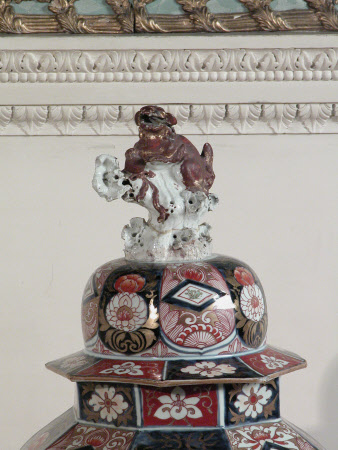Jar lid
Category
Ceramics
Date
1700 - 1720
Materials
Porcelain, cobalt, enamel, gold.
Place of origin
Arita
Order this imageCollection
Saltram, Devon
NT 870793.2.2
Summary
Lid for one of a pair of jars, porcelain, octagonal, domed, topped with a Buddhist lion on rockwork, made in Arita, Hizen Province, Japan, 1700–20, decorated in the Imari palette in underglaze blue and overglaze red, black and green enamels and gold with stylised rosettes and lozenges on alternating black and red grounds, the rock white and the lion red with traces of gilding.
Full description
In the early 18th century, the porcelain made at the Arita kilns for export to Europe became increasingly exuberant (Ferguson 2016). The various motifs had specific meanings in the Japanese context, but on export wares they were used more to create dense visual patterns that appealed to European late-baroque taste. In European interiors jars such as these were used as grand visual punctuation marks, in pairs or as symmetrical sets or ‘garnitures’. For a third jar of the same type at Saltram, see NT 870945. A somewhat similar faceted Imari baluster jar is in the collection of the Staatliche Kunstsammlungen Dresden, inv. no. PO 414, with a likely provenance from Augustus II (known as ‘the Strong’), Elector of Saxony (1670–1733).
Provenance
Given to the National Trust by Montagu Brownlow Parker, 5th Earl of Morley (1878-1962), 1957.
References
Ferguson 2016: Patricia F. Ferguson, Ceramics: 400 Years of British Collecting in 100 Masterpieces, Philip Wilson Publishers, 2016, pp. 70-1
